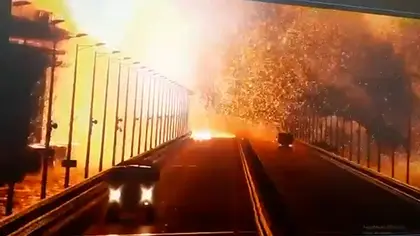On the morning of October 8, 2022, the detonation of explosives equivalent to 10 tons of TNT, hidden in a truck, brought down two spans of the Kerch Bridge, which connected occupied Crimea to the Russian mainland.
Russian forensic and criminal investigations into the incident have concluded that the explosive used was an improvised mix of potassium or sodium perchlorates and finely dispersed metals obtained from solid rocket fuel along with a small military plastic explosive initiating charge along with a GPS controlled trigger.
JOIN US ON TELEGRAM
Follow our coverage of the war on the @Kyivpost_official.
The explosives were hidden in rolls of plastic film loaded onto 22 pallets with a total weight of around 23 tons. The layers of 0.1-millimeter-thick polyethylene film not only camouflaged the bomb but also acted as the body of the explosive device ensuring sufficient time for the explosives to fully function.
The improvised explosive device (IED) was detonated when the truck reached the 156th kilometer point on the A290 Novorossiysk-Kerch motorway across the bridge.
Kommersant’s sources say the consignment originated in Odesa where it was sent in early August to the Bulgarian town of Ruse before moving on to Poti, in Georgia and then Yerevan. The load was cleared through the Transalyans cargo terminal, moved to a DAF truck, and parts of the accompanying documentation were replaced or altered.
The film on the replacement truck crossed the Georgian-Russian border at the Verkhny Lars checkpoint on Oct. 4 and was delivered to the wholesale depot in Armavir, in Russia's Krasnodar Krairegion, two days later. Here the pallets were again transferred to an International ProStar truck with a trailer for delivery to a Simferopol-based company. This final truck was driven by a Russian citizen, Makhir Yusubov, who seems to have been unaware of the true nature of the load.

Russia Guards Combat Dolphins in Crimea With Pantsir-S1 (SA-22) System
The conclusion of Russia’s Investigative Committee and the Federal Security Services (FSB) was that the operation had been planned by the then deputy head of Ukraine’s Security Services (SBU), Vasily Maliuk. They believe that he had been given the task of planning an attack almost immediately after being appointed by President Vladimir Zelensky in March 2022. At the time of the attack on the bridge he was effectively the acting head of the SBU.
The FSB believes that several citizens of Russia, Armenia and Ukraine were involved in the preparation and initiation of the attack. These are named as Oleg Antipov, Alexander Bylin, Dmitry Tyazhelykh, Artem and Georgy Azatyan, Roman Solomko, Vladimir Zloba, Artur Terchanyan, as well as Maliuk who have been “arrested in absentia and put on the international wanted list.”
Kommersant reported that the final report runs to more than 100 volumes and will be finally completed and released in June this year.
A second attack on the bridge by Ukrainian unmanned surface vessels (USV) drones on July 17, 2023, damaged two additional spans of the bridge and killed a Russian family from Belgorod who were crossing the bridge at the time. Russian Deputy Prime Minister Marat Khusnullin admitted at the time that one span was damaged beyond repair
Since then, Ukraine has promised further attacks on the bridge, both for its strategic and propaganda importance as one of President Putin’s high-profile achievements. Vice Admiral Oleksiy Neyizhpapa, spokesman for the Ukrainian navy said in February that “the Crimean Bridge will be destroyed by the end of the year.” Kyrylo Budanov, head of Ukraine’s military intelligence (HUR) also hinted that Ukraine would strike again advising “people against using the bridge.”
In response Russia has intensified defenses around the link. This has included additional air defense assets, anti-drone booms and barges blocking both surface and underwater sea approaches, as well as intensified searches of and restrictions on vehicles wishing to cross the bridge.
You can also highlight the text and press Ctrl + Enter






